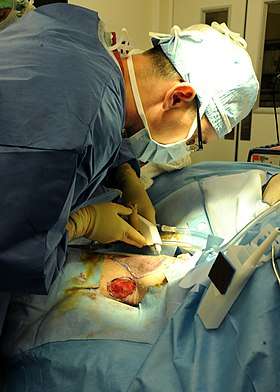Reconstructive surgery
Reconstructive surgery is, in its broadest sense, synonymous with plastic surgery.[1] Commonly, however, reconstructive surgery is understood as the use of surgery to restore the form and function of the body, which does not include aesthetic or plastic surgery. For example, plastic surgeons, maxillo-facial surgeons and otolaryngologists do reconstructive surgery on faces after trauma and to reconstruct the head and neck after cancer.[2]
| Reconstructive surgery | |
|---|---|
 Skin grafting: an example of reconstructive procedure. US Navy 110420-N-UB993-105 Capt. Craig Salt, a plastic surgeon assigned to Naval Medical Center San Diego, performs a skin graft as part of the Pro |
Reconstructive surgery represents a small but critical component of the comprehensive care of cancer patients. Its primary role in the treatment of cancer patients is to extend the ability of other surgeons and specialists to more radically treat cancer, offering patients the best opportunity for cure.[3]
Other branches of surgery (e.g., general surgery, gynecological surgery, pediatric surgery, plastic surgery, podiatric surgery) also perform some reconstructive procedures. The common feature is that the operation attempts to restore the anatomy or the function of the body part to normal.
Reconstructive surgeons use the concept of a reconstructive ladder to manage increasingly complex wounds. This ranges from very simple techniques such as primary closure and dressings to more complex skin grafts, tissue expansion and free flaps.
Cosmetic surgery procedures include breast enhancement, reduction and lift, face lift, forehead lift, upper and lower eyelid surgery (blepharoplasty), laser skin resurfacing (laser resurfacing), chemical peel, nose reshaping (rhinoplasty), reconstruction liposuction, nasal reconstruction using the paramedian flap, as well as tummy tuck (abdominoplasty).
Many of these procedures are constantly being improved.
In 2010 only 10 research papers were identified which looked at reconstructive surgery after massive weight loss.[4]
Use of implants and biomaterials
Recent literature in medline also has noted implementation of barbed suture in these procedures.[5]
Biomaterials are, in their simplest form, plastic implants used to correct or replace damaged body parts. Biomaterials were not used for reconstructive purposes until after World War II due to the new and improved technology and the tremendous need for the correction of damaged body parts that could replace transplantation. The process involves scientific and medical research to ensure that the biomaterials are biocompatible and that they can assume the mechanical and functioning roles of the components they are replacing.
A successful implantation can best be achieved by a team that understands not only the anatomical, physiological, biochemical, and pathological aspects of the problem, but also comprehends bioengineering. Cellular and tissue engineering is crucial to know for reconstructive procedures.[6]
An overview on the standardization and control of biomedical devices has recently been gathered by D. G. Singleton. Papers have covered in depth the U.S. Food and Drug Administration (FDA) Premarket Approval Process (J. L. Ely) and FDA regulations governing Class III devices. Two papers have described how the National Institute of Standards and Technology, American Dental Association, National Institute of Dental and Craniofacial Research, and private dental companies have collaborated in a number of important advances in dental materials, devices, and analytical systems.
References
- Macionis V. Definition of plastic surgery: A historical perspective. Journal of Plastic, Reconstructive & Aesthetic Surgery. 2017;70:132-133.
- "Reconstructive procedures". Retrieved 2019-10-28.
- Hasen K.V., Few J.W., Fine N.A., (2002), Plastic surgery: a component in the comprehensive care of cancer patients. Oncology 16(12). p. 1685-98. PMID 12520643.
- Gilmartin, J. (2011). "A critical literature review: the impact of reconstructive surgery following massive weight loss on patient quality of life". Journal of Nursing and Healthcare of Chronic Illnesses. 3 (3): 209–221. doi:10.1111/j.1752-9824.2011.01100.x.
- Hammond DC. "Barbed sutures in plastic surgery: a personal experience". Aesthetic Surgery Journal. 33: 32S–9S. doi:10.1177/1090820X13499578. PMID 24084877.
- Sarah Al-Himdani, et al. "Tissue-Engineered Solutions in Plastic and Reconstructive Surgery: Principles and Practice". 4 (4). 2017. doi:10.3389/fsurg.2017.00004. PMC 5322281. PMID 28280722. Cite journal requires
|journal=(help)